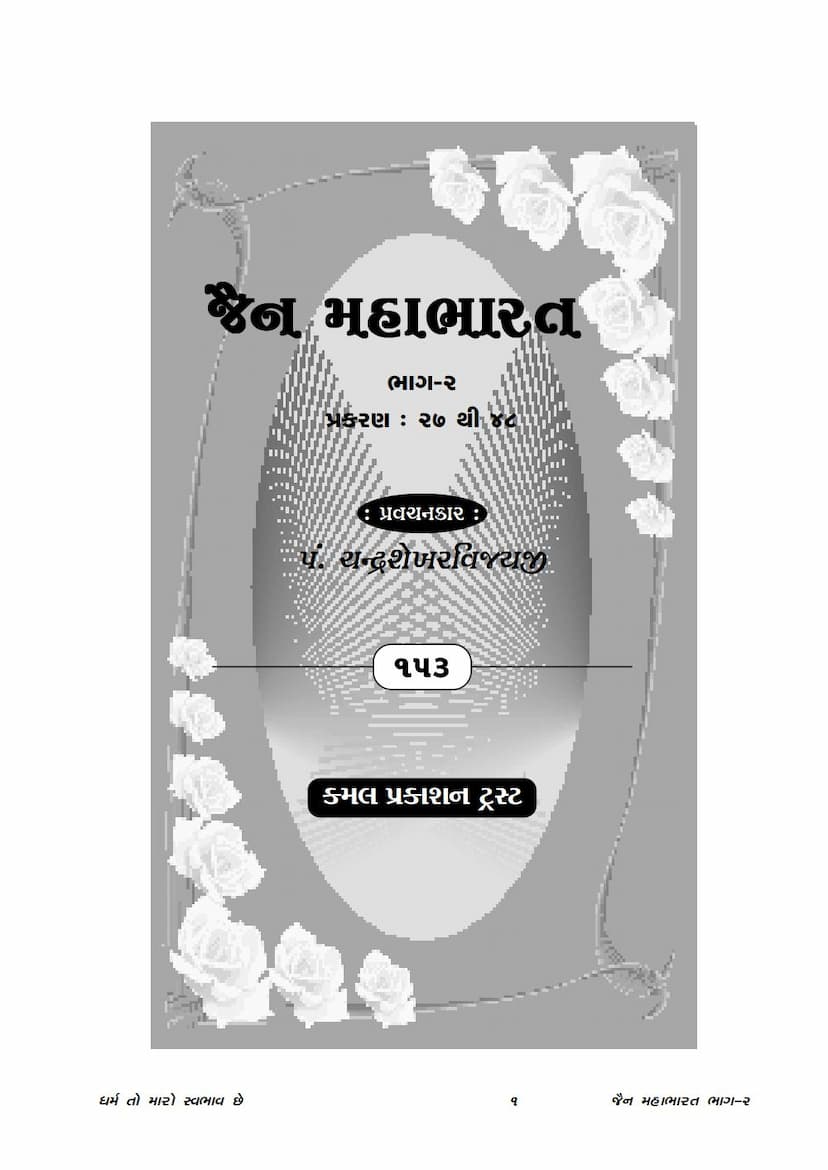Jain Mahabharat Part 02
Added to library: September 2, 2025

Summary
Here's a comprehensive summary of "Jain Mahabharat Part 02" by Chandrashekharvijay, based on the provided text:
This book, "Jain Mahabharat Part 02," authored by Pujya Pandit Shri Chandrashekharvijayji, is a narrative, critical, and analytical exploration of the Mahabharata from a Jain perspective. It aims to provide a unique understanding of the epic's characters and events, offering lessons on living a righteous life.
Key Themes and Content:
The book presents a Jain interpretation of the Mahabharata, highlighting the inherent Dharma (righteousness) that is considered the natural disposition of the soul. It draws parallels and contrasts with the non-Jain version of the epic where necessary, emphasizing the dignity and principles of Jainism.
Detailed Chapter Summaries (based on the index and content):
The book covers a wide range of events and characters from the Mahabharata, reinterpreted through a Jain lens:
- Character Analysis: It delves into the personalities of major Mahabharata figures like Krishna, Bhishma, Duryodhana, Karna, Vidura, Dronacharya, Ashwatthama, and Draupadi, offering unique and insightful characterizations.
- Draupadi and Kunti's Passion (Chapter 27): This section likely explores the emotional turmoil and strong reactions of Draupadi and Kunti, emphasizing their faith and devotion, and how their conduct relates to Jain principles of equanimity and detachment. The text highlights Draupadi's "dynamic" nature versus Yudhishthira's "static" nature, and the importance of avoiding expectation, anger, and impatience. It stresses the value of simple living, purity, and the power of devotion.
- The Pandavas' Journey and Trials: The narrative likely follows the Pandavas through their exile and various challenges, including their stay in the Gandhamadana mountain and their time in disguise during the secret (Guptavas).
- The Lotus and its Aftermath (Chapter 28): The story of the lotus appearing before Draupadi and the subsequent events, including Bhima and Arjuna getting lost in the lake, is presented. This likely serves as a lesson on desires, the consequences of seeking worldly pleasures, and the importance of a simple, unblemished life. It emphasizes that desires lead to suffering and the need to renounce them.
- The Secret Abode (Chapter 31): This chapter covers the Pandavas' incognito year, their disguised identities, the encounter with Kichaka, Bhima's role in killing Kichaka and his brothers, and the dramatic events surrounding the abduction and eventual rescue of Draupadi. It highlights the power of faith, the Navkar Mantra, and the strength of devotion.
- Key Encounters and Conflicts:
- The Confrontation with Duryodhana (Chapter 29): This section likely deals with Duryodhana's capture and the efforts to release him, emphasizing the Jain ideal of treating even enemies with kindness and the concept of being "one hundred and five, not just five." It might also touch upon the downfall of Yadavas and the politics of that era.
- The Demonic Kritiya (Chapter 30): This chapter seems to detail an encounter with a demonic entity named Kritiya, possibly highlighting the power of righteous conduct and faith in overcoming evil forces. It might also involve the Pandavas' rescue through divine intervention.
- Krishna's Role as a Diplomat and Strategist (Chapter 32): Krishna's efforts to negotiate peace and his eventual role in preparing for the war are likely discussed. The chapter touches upon the hypocrisy of forced non-violence, the unwavering determination of Yudhishthira, and the inevitability of divine justice. It also covers Krishna's attempts to prevent war and his strategic political maneuvers.
- Arjuna's Despair and Krishna's Discourse (Chapter 35): This chapter focuses on Arjuna's emotional distress before the war and Krishna's profound teachings on Dharma, duty, and the nature of reality, which form the core of the Bhagavad Gita. It emphasizes the importance of inner strength, detachment from worldly desires, and the ultimate triumph of righteousness.
- The Great War (Chapters 36-39): This extensive section details the major battles and significant events of the Kurukshetra war, including the leadership of Bhishma, Dronacharya, Karna, and Shalya. It highlights acts of valor, sacrifice, and the adherence to principles, even amidst conflict. It also likely points out the detrimental effects of attachments, ego, and the misuse of power. The summary of the war emphasizes the inherent strength of virtue and righteousness, even in the face of overwhelming odds.
- The Aftermath of the War: The book concludes with the demise of Krishna, the destruction of Dwarka, and the eventual renunciation and liberation of the Pandavas and other prominent figures. It reflects on the cyclic nature of karma and the ultimate path to salvation.
- The Power of Faith and Righteousness: Throughout the book, there's a recurring emphasis on the power of faith, devotion, and righteous conduct in overcoming adversity and achieving ultimate liberation. The examples of heroes and heroines who displayed immense courage and adherence to Dharma serve as inspiration.
- Social and Ethical Commentary: The book also offers commentary on societal issues and ethical dilemmas, urging readers to embrace virtues like honesty, compassion, and self-control, and to reject vices like greed, anger, and arrogance.
Key Takeaways:
- "Dharma is my nature": This central theme underscores the Jain belief that righteousness is an inherent quality of the soul, which individuals should strive to realize and uphold.
- Reinterpretation of Characters: The text offers a unique Jain perspective on the Mahabharata characters, often highlighting their adherence to Jain ethical principles or reinterpreting their actions in light of these principles.
- Lessons for Life: The book aims to impart practical lessons on life, ethics, and spirituality, encouraging readers to cultivate inner strength, practice compassion, and strive for liberation.
- Emphasis on Inner Purity: The narrative consistently points towards the importance of inner purity, devotion, and adherence to Dharma as the true path to success and peace, both in this life and beyond.
In essence, "Jain Mahabharat Part 02" is a significant work that bridges the epic narrative of the Mahabharata with the profound philosophical and ethical teachings of Jainism, offering a spiritually enriching experience for its readers.